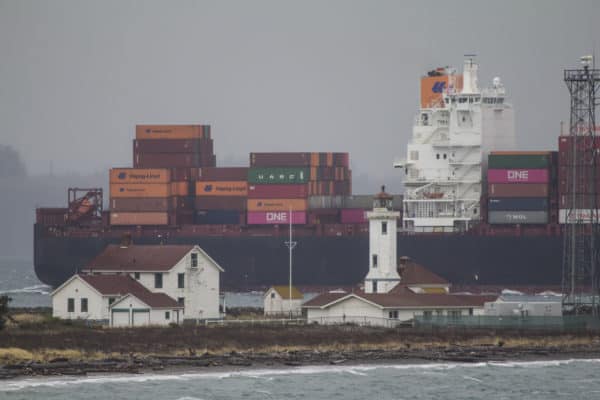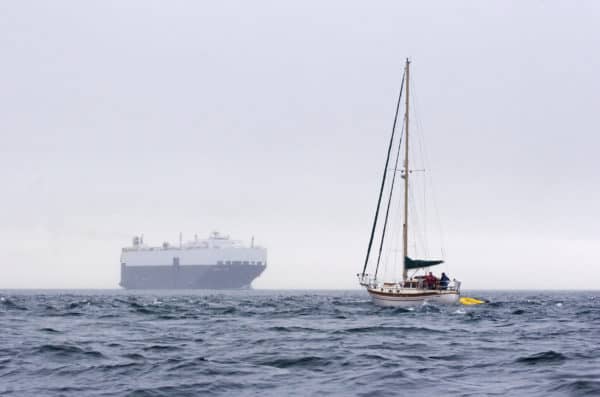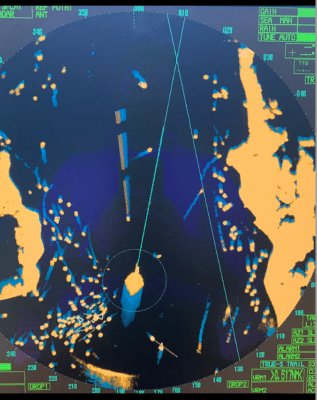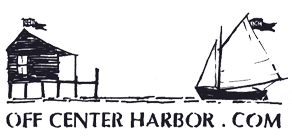Email This Page to a FriendPreview: What Puget Sound Pilots Want You to Know
June 7, 2022
What Puget Sound Pilots Want You to Know
by Karen Sullivan

Container ship, entering Admiralty Inlet, Port Townsend, Washington State, USA, Pacific Northwest, © Joel Rogers Photography.
It may sound counterintuitive, but when a big ship leaves the high seas and enters the restricted waters of Puget Sound, it is entering the most dangerous part of its voyage. Imagine placing a skyscraper full of oil or cargo on its side and trying to steer it through narrowing waterways with many turns and lots of commercial and recreational traffic crossing its path—a skyscraper with a stopping distance of several miles, whose ability to steer gets less effective the slower it goes.
We need highly trained experts with encyclopedic knowledge of our waters in all weather conditions, to guide these big ships into port, because mistakes can be extremely costly. By navigating safely, our maritime pilots protect Puget Sound and the lives and property of those who use its waters. By understanding what they want you to know and do in order to stay safe on the water, you can help.

Freighter passing sailboat, off Port Townsend, Washington State, Pacific Northwest, USA, sloop “Walden” outbound, © Joel Rogers Photography.
I spent an hour in conversation with Severin Knutsen, a Puget Sound Pilot and son of Port Townsend shipwright Leif Knutsen and his wife Joan. I asked, “What’s the main message that Puget Sound Pilots want the public to know?”
“If in doubt about whether you’ve got a problem with crossing the path of an oncoming ship,” he said, “please pass astern of us. Most people can see where we’re going; we’re transiting in the [shipping] lanes, and we’re heading to one of the major ports. But we don’t always know where you’re going. If you can make your actions significant, obvious, and early enough like the rules say, then that’s one less thing for us to worry about in making sure you’re safe. You can help by making, for example, a large and obvious course change early enough to avoid a dangerous situation. When you do that and point your boat astern of our ship, we think, ‘okay, I know what you’re doing now; thank you.’ That’s the easiest way to signal us.”
By rules, Knutsen means the International Collision Regulations, known as 72COLREGS. If boaters are transiting shipping lanes they should know Rule 10, which basically says that a vessel less than 20 meters shall not impede a ship transiting in the lanes. “A lot of people may think, oh we’re sailing, we have the right of way,” said Knutsen, “but it’s not necessarily the case in the lanes.”

Radar image from bridge of outbound ship (center), small vessels in inbound lane. Image capture by Severin Knutsen.
While pilots will often respond to radio calls from small boats who may have doubts about the safety of a crossing situation with a big ship, Knutsen showed me a radar image (below) of what it can be like for a ship trying to navigate safely. “I was northbound in this image,” he said, “but most of these small vessels are in the southbound lane. You can see that if everybody called us, we’d never get off the radio.” Meanwhile, he tries to determine who’s giving way, who is not, and which boats he needs to worry about. Big ships can’t often read small boat names, and most small boats don’t have AIS (Automatic Identification System). So, the primary means of communication for the ship is heading changes. “We try to make course changes significant and early, so people know, ‘okay, the ship’s going that way, I can go this way and stay safe,’ he added. “The other communications tool we have is our whistles.” (To most ears they sound like fog horns.)
The bottom line is, if a ship is
. . . sign up to the right to get immediate access to this full post,
plus you'll get 10 of our best videos for free.
Get Free Videos& Learn More Join Now!!for Full Access Members Sign In

